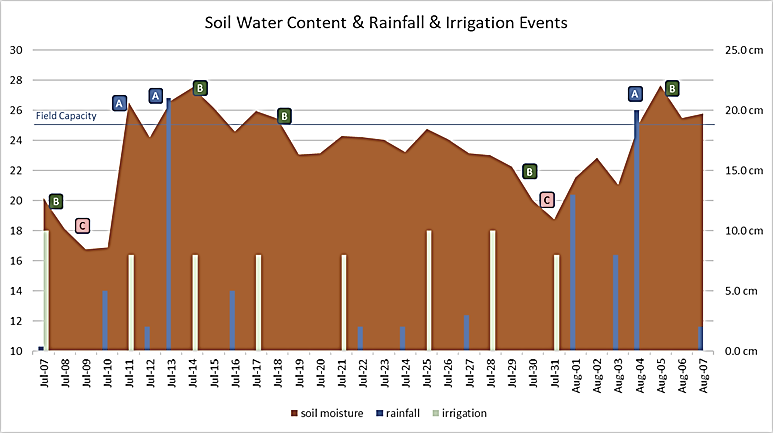WHAT’S HAPPENING IN YOUR SOIL?
AG Technology Consultant
This article provides a behind-the-scenes look into the data that growers use to increase crop production. It describes actual data from Michael, a strawberry grower based near Guelph, Ontario, during the summer of 2017. Michael had been working with soil specialists from the Ministry of Agriculture who had advised him to irrigate several times a week; however, it was a relatively wet summer and Michael wanted to see if he was making the right kind of adjustments for rain, soil type, and growth stage.
We analyzed daily and hourly water data for July from a Standard Sensor Solution. Mike had installed sensors about 6 inches deep and was growing on a layer of sand on top of a layer of sandy loam. We’ve exported the chart from the sensors and added data based on his irrigation log and also tracked rainfall in the area.
1. Soil moisture level is taken from our real sensor readings of the farm
2. Rainfall is recorded from the average reported by the Weather Network in that area on that day
3. Irrigation level is taken from Michael’s logs. Note* irrigation event is based on irrigation log, assuming 1 hour of irrigation is equivalent to 4 cm of rain.
The ConnectedCrops team noticed three important types of events based on the analysis;
Daily Tracking Chart:

A – significant rise in soil water content due to rain or irrigation event on Jul 11, Jul 15, Aug 5.
Over Watering
The field capacity was reached for this specific soil type and the irrigation was continued beyond the requirement of the crop. The water consumption can be avoided, keeping irrigations costs in control. Plants in water logged soil suffer from a lack of oxygen, which leads to the death of roots and a loss of vigor in the plant. It can also cause lead to growth of certain fungal pathogens.
Stunted slow growth with yellowing leaves is a symptom of over watering. Plants may suffer from leaf scorch or leaf burn.
Suggestions:
1. We suggest to check if the soil is heavily or poorly drained, as they are susceptible to becoming waterlogged.
2. Water less frequently but for longer periods, so water reaches deep into soil. Good thorough watering promotes healthier plants.
3. Adjust watering frequency and amounts based on season, temperature and amount of rainfall.
4. make sure you don’t have leaking irrigation pipes or downspouts that are keeping the soil too wet in a location.
5. Adding organic matter can improve drainage in heavy clay soils.
6. The surface generally dries out first and is not a true indicator of what is going on down deep near the plant root. Use ConnectedCrops sensors to know moisture levels at different depths.
B – significant drop in soil water content due to heavy crop absorption related to growth stage or heat stress on Jul 7, Jul 15, Jul 18, 29, Aug 5.
C – opportunities to irrigate earlier to make more water available to crop on Jul 8, Jul 30
Under Watering
The result of water scarcity on a regular basis can cause reduce overall plant growth and yield.
Suggestions:
1. Improve soil structure to remove barriers to plant growth, including adding clay soil if needed to retain more water
2. Increase organic matter to improve water infiltration.
3. Deep ripping compacted subsoils- Poor root growth and swollen root tips can indicate a compacted layer (hardpan), usually between 10 and 40 cm.
We also tracked the hourly data for a week and we noticed the following types of events:
A – soil water content increasing based on irrigation or rain events at approximately: Aug 1 8:00AM, Aug 4 1:00AM, Aug 4 11:00PM
B – crops are absorbing on average 1.5% to 2% of available water content during day: Aug 2- 1:00PM, Aug 3- 2:00PM, Aug 5- 1:00PM, Aug 6- 2:00PM. We also noticed that a very little to no water is being absorbed at night (which is to be expected).
See hourly chart below:

Michael found that he was overwatering and underwatering; but never knew when, even though he was working with soil experts and advisors. The ConnectedCrops station provides real-time information on a hourly basis and indicates how much water is absorbed by the crop, and how much water stays in the soil after a rain fall and irrigation session. Michael still has to make adjustments based on crop type and growth stage but he has a much clearer picture on how much water the plants have access to at any one time.
You can become an expert too! Reach out to us to know more about our soil sensing technology.